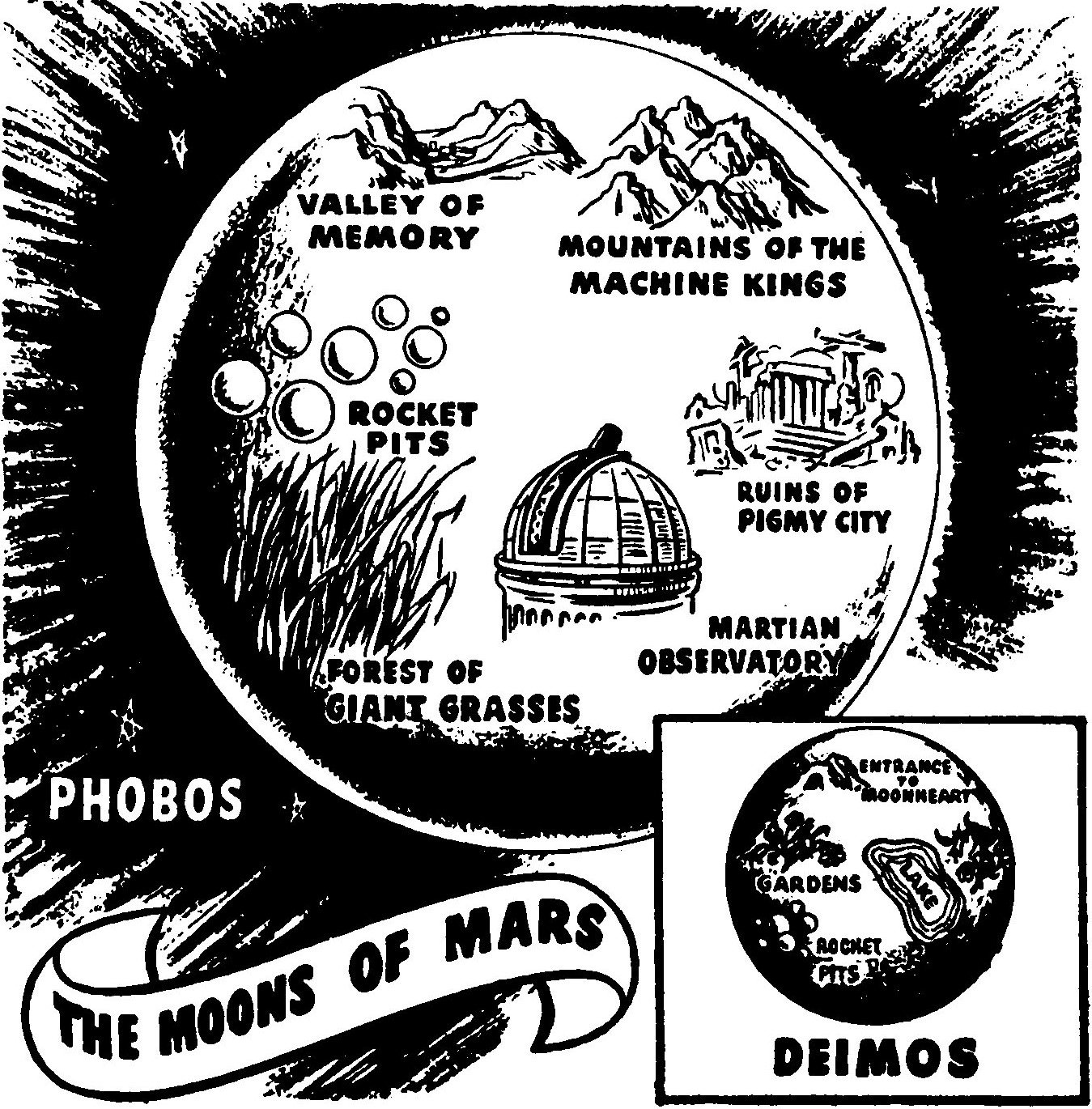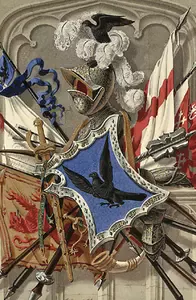what to see on
phobos
The scene on Mars' inner moon...
perilous forest on phobos
The most remarkable feature of the following two days was the fact that we survived them. We found food in plenty; and as we were always near the river, we never suffered for lack of water; but by day and by night we were constantly in danger of attack by the roving flesh-eaters.
We always sought to save ourselves by climbing into trees, but upon three occasions we were taken by surprise; and I was forced to fall back upon my sword, which had seemed to me a most inadequate weapon of defense against some of the ferocious beasts that assailed us.
However, in these three instances, I managed to kill our attackers, although, I must confess, that it seemed to me then, and still does, wholly a matter of luck that I succeeded.
By now, Ozara was in a more sanguine frame of mind. Having survived this long, she felt that it was entirely possible that we might live to reach Domnia, although originally she had been confident that we could not come through the first night alive.
She was often quite gay now, and she was really very good company. Especially was this true on the morning of the third day as we were making good progress towards our goal.
The forest seemed to be unusually quiet; and we had seen no dangerous beasts all that day, when suddenly a chorus of hideous roars arose all about us; and simultaneously a score or more of creatures dropped from the concealing foliage of the trees about us.
Ozara’s happy chatter died on her lips. “The Masenas!” she cried.
As they surrounded us and started to close in on us, their roaring ceased and they commenced to meow and purr. This, to me, seemed far more horrifying…
Edgar Rice Burroughs, Swords of Mars (1936)
>> Guess The World - Third Series
phobos - larger than we thought
Phobos rushed up before them, a horribly barren world that seemed to encompass all of space. Closer it came, but Kueelo didn't check his drive. They could see vast plains dotted with craters, and huge serrated cliffs reaching up.
At last Kueelo applied his forward thrust, and they levelled out. Half around the planet they raced. A mountain range loomed. The spacer dipped sharply, driving straight at it! Ric was taut, sweat glistening on his brow. No ship could ever brake in time at that suicidal speed! He merely closed his eyes, awaiting the inevitable.
A sudden force sent him reeling. A profound nausea made him retch. Then Kueelo was at his side, touching his shoulder.
"How was that, Earthman?" Kueelo laughed. "Don't worry, we're safe now!"
White-faced and shaken, Ric opened his eyes. They had entered a place of semi-darkness, but were still moving ahead.
"Where are we?"
"Inside the cliffs! We've entered a magnetic field that arrests speed and mass synchronously. We are being slowed in a graduating net of force."
In a few minutes they had come to a complete rest, but Kueelo told them, "Stay where you are! Our trip isn't over yet."
Ric peered into the forward screen. Darkness encompassed them. He turned questioningly. Kueelo grinned and gestured downward.
"You mean we're going inside this planet?"
"Yes. Very far inside. We're on the downward beams now. Patience, Earthman, you'll see many amazing things before we're through."
It took a long time, and there was no telling how far they'd gone or with what speed. They seemed not to be moving at all. But at last a faint blue radiance appeared, and Kueelo opened the lock.
They stepped out onto a ledge which extended perhaps a hundred yards, then dropped sheerly away. The walls curving up were of polished smoothness, and stretched away into unimaginable distances. The soft bluish light came from these walls and seemed to pervade the whole interior of this hollow world. The air was damp but comfortably warm. And the gravity....
Praana clutched at Tal Horan's arm. "This is almost Mars gravity! But ... where do they get it?"
"Yes, we'll have to look into that later." Tal cautioned her to silence.
A three-wheeled car was waiting for them. Kueelo hurried them into it, and Naric took the controls. Soon they were speeding away, and they gasped as their ledge tapered off into nothingness! They were traversing the inside of the shell itself.
"It's eerie at first," Kueelo told them, "but you'll soon become accustomed to our gravity. Just imagine the space out there as being up. The only difference is that our light comes from the surface instead of overhead."
"What's the interior diameter?" Ric gestured outward.
"About three hundred miles. And you were wondering about our gravity, Tal Horan? It comes from out there!" Kueelo gestured vaguely at the gray-blue interior. "Our power plant is anchored in space at the exact center of Phobos. But it's reverse gravity—that is to say, its force extends outward toward the shell, instead of pulling inward."
Tal saw that the man was communicative. He nodded thoughtfully. "Quite an engineering feat! It must have taken a long time to set up all this!"
"Two generations! It was not done in my time."
"Where are we going now?"
"To the city of the Phobians."
Praana gasped. "Native Phobians? But there are no Phobians left! For three hundred years—"
"That's the popular supposition, and it suits our convenience. Yes, three hundred years ago the war between Mars and Phobos was supposed to have ended. But you shall see! Perhaps Gorak himself will have much to tell you."
"Gorak?"
"The present Phobian leader! There are only a few thousand Phobians remaining, as there are only a few thousand of your people. Ironic, is it not ... Princess Praana?"
Albert de Pina, Moon of Danger (Planet Stories, Summer 1947)
>> Guess The World - Third Series
a city inside phobos
A lift carried them swiftly up through milkily luminescent regions and came to rest at last in a place of complete darkness. Jor Therol led them through devious passages until they emerged into the open.
Ridge Coler stood staring then. They were in an enclosed court on the roof of a tall, circular edifice. In all directions stretched the broad avenues and varicolored structures of the city of Scarta; in all directions literally, for the city was built upon the inner wall of the enormous hollow globe which was Phobos. Overhead, at a distance of nine miles or more, were other avenues and other buildings; inverted, dangling precariously above them, it seemed.
In the exact center of the sphere was an artificial sun, casting its blue-white light uniformly over the entire city. Below them, and as far as the eyes could follow, the up-curving streets were alive with fast-moving traffic; two-wheeled vehicles speeding in the center lanes, moving belts at both sides swarming with foot passengers.
In the air above were darting figures, men and women of Scarta — flying. Strapped between their shoulders were torpedo-shaped things, and these glowed a brilliant phosphorescent green. These were levitators, Jor Therol explained; nullifying gravity; controlling its effect in any desired direction and intensity.
“But,” objected Coler, “what of gravity in the city itself? How is it that overhead the pull is opposite in direction?”
“It is an artificial gravity.” Jor Therol took three levitators from a rack and examined their mechanisms as he spoke. “The energies are in the shell which incloses us. In the center of the sphere the attraction is equal in all directions; therefore our artificial sun needs no support.”
Harl Vincent, Lost City of Mars (Astounding Stories, February 1934)
>> Guess The World - Third Series
tiny ruins on phobos

…Those few surviving Machine Kings were hunted down in the rocky hills of Phobos.
But legend persists that one or two of the ancient Machine Kings still lurk in the wild recesses of those hills, immortally. This legend has given the hills their name.
In other hills to the westward there lies a narrow defile which is famous throughout the System as the Valley of Memory. It is filled with a curious gas that seeps from the interior of Phobos – a combination of certain halogens with unfamiliar radioactive qualities.
This gas, when breathed by a human being, has the odd pathological effect of slowly erasing the memory-patterns of the cortex of the human brain.
It always operates on the brain in reverse chronological order…
…Another curious feature of Phobos, and one that has been the subject of much interest, is the so-called Pigmy City. This is a ruined city that was discovered in the giant grasses of the southeast. Its architecture is not unusually striking.
The sensational thing about it is that the city is inconceivably tiny. Its minute buildings are no more than ten inches in height, and the whole metropolis of some thousands of tiny buildings only covers a space fifty feet across.
It is quite obvious that this ruined city was built by a race smaller in size than any planetary people of the present System. Many scientists believe that such a race once evolved on Phobos, and was swept away by some catastrophe long ago…
The Moons of Mars (article in Captain Future, Fall 1942)
>> Guess The World - Third Series
robot liquor-moonshiner on phobos
…The first generation of the metal people – more than fifty thousand of us – were obsolete. The things that we had been designed to do, the new ones, with their crystalline brains, fresh, untarnished, accomplished better.
We were banished to Phobos, dreary, lifeless moon of Mars. It had long been a sort of interplanetary junkyard; now it became a graveyard.
Upon the barren face of this little world there was no life except for the handful of hardy Martian and Terran prospectors who searched for minerals. Later on, a few rude mining communities sprang up under plastic airdromes, but never came to much. Argon City was such a place…
Charles A Stearns, B-12's Moon Glow (Planet Stories, January 1954)
>> Guess The World - Fourth Series





































